The article below includes excerpts from my book, Essential Oils for Mindfulness and Meditation. You will also find further details about the safe and effective application of essential oils in my other books, Healing with Essential Oils and Essential Oils for the Whole Body (available to purchase or order from most book outlets).
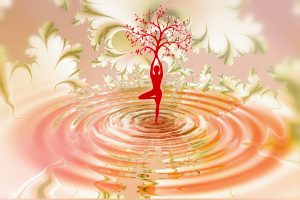 How do I write about meditation, how do I express an experience that seems to transcend words, their boundaries, their limits? How do I pour the ocean into a cup? I attempt to paint a picture: the profound wordless awareness that every drop of water IS the ocean, momentarily separate, but essentially the same. Words, expressions of colour and shade, applied to paint an impression, to portray a sense of the experience: an infinite drop wrapped in a finite skin, a membrane holding a fragment of the entire ocean; similes, stories and parables touching wordless truth.
How do I write about meditation, how do I express an experience that seems to transcend words, their boundaries, their limits? How do I pour the ocean into a cup? I attempt to paint a picture: the profound wordless awareness that every drop of water IS the ocean, momentarily separate, but essentially the same. Words, expressions of colour and shade, applied to paint an impression, to portray a sense of the experience: an infinite drop wrapped in a finite skin, a membrane holding a fragment of the entire ocean; similes, stories and parables touching wordless truth.
At the epicentre of the storm, there is calm; at the centre of chaos, stillness; at the heart of being, peace. Meditation returns consciousness to the peace, stillness, and calm at the epicenter of our being. Remaining mindfully aware, we are present and consciously engaged in the here and now. And thus, the boundaries of the moment melt, dissolve, as we tap into the infinite ocean; possibility endless, potential limitless, belonging undeniable.
 The techniques of mindful attention (focus or meditation) take the perceiver to the well, but the techniques are not the water. The water (experience) drawn from the well and contained within the cup (mindful attention, focus or meditation) offers a taste, an insight, of the ocean. So, the techniques of meditation, or concentrated focus, can be seen as the cup that enables the perceiver to draw from the inner depths of the well, awareness of innate and infinite spirit within, not remote, outside, above, or beyond, but inside and available, within every cell.
The techniques of mindful attention (focus or meditation) take the perceiver to the well, but the techniques are not the water. The water (experience) drawn from the well and contained within the cup (mindful attention, focus or meditation) offers a taste, an insight, of the ocean. So, the techniques of meditation, or concentrated focus, can be seen as the cup that enables the perceiver to draw from the inner depths of the well, awareness of innate and infinite spirit within, not remote, outside, above, or beyond, but inside and available, within every cell.
Ironically, or perhaps paradoxically, the term ‘mindful’ seems counter intuitive, when we are, in fact, attempting to have ‘less mind’, to still and quieten its incessant chatter as it draws our conscious awareness into the past, the future, plays out abstract scenes and conversations, and obscures our ‘vision’; our sensual experience of simply being present here and now. Our mind is a wonderful tool and serves us well, but uncontrolled, the servant appears to become the master and there is an insidious shift of power as the ‘horse takes the reigns from the driver’ and we appear to hurtle without conscious control from one thing (thought, idea, imagination, insight, sensation, experience) to the next. Meditation allows us to sit at the center at the heart of our being, the center of the see-saw where it is still, to observe, and regain conscious choice and control, to notice, acknowledge and appreciate, with a sense of curiosity, awe and gratitude, to simply be.
So, how do essential oils feature in this relationship?
 Combining fragrance with meditation is an ancient practice. Essential oils have accompanied our journey through time, like guardians and companions, uplifting our spirits, protecting our body, providing hedonistic pleasure; incense released from burning wood, leaves and plant resins during ceremony, rite, ritual and prayer, worn as perfumes, applied in salves to heal wounds, and in fumigants to cleanse the environment. There are numerous references found in historical texts:
Combining fragrance with meditation is an ancient practice. Essential oils have accompanied our journey through time, like guardians and companions, uplifting our spirits, protecting our body, providing hedonistic pleasure; incense released from burning wood, leaves and plant resins during ceremony, rite, ritual and prayer, worn as perfumes, applied in salves to heal wounds, and in fumigants to cleanse the environment. There are numerous references found in historical texts:
Then The Lord said to Moses, “Take fragrant spices – gum resin, onycha and galbanum – and pure frankincense, all in equal amounts, and make a fragrant blend of incense, the work of the perfumer.” Exodus 30:34
The smoke of the incense, together with the prayers of God’s people, went up before God from the angel’s hand. Revelations 8:4
The herbs ought to be distilled when they are in their greatest vigor, and so ought the Flowers also. Nicholas Culpepper (1616-1654)
There is no doubt we share a symbiotic relationship with plants; from the oxygen we breathe, to vital nutrients that support our body’s metabolic function. Indeed, essential oils possess numerous qualities, from anti microbial and skin healing to psycho-emotional and ethereal.
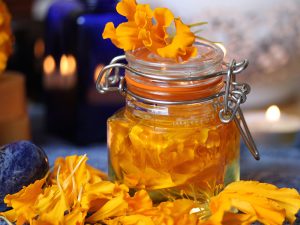 Historically, essential oils were extracted by expression (crushing) or maceration (soaking in water, fat or oil) from bark, leaves and twigs, heartwood, resin, herbs and flowers. Today, essential oils are extracted by steam distillation, solvent extraction (usually delicate flowers), or expression (usually citrus fruit peel), from various parts of plants – blossoms, flowering heads, leaves, grass, resin, bark, twigs, roots, fruits and seeds.
Historically, essential oils were extracted by expression (crushing) or maceration (soaking in water, fat or oil) from bark, leaves and twigs, heartwood, resin, herbs and flowers. Today, essential oils are extracted by steam distillation, solvent extraction (usually delicate flowers), or expression (usually citrus fruit peel), from various parts of plants – blossoms, flowering heads, leaves, grass, resin, bark, twigs, roots, fruits and seeds.
The immediacy of odour detection, the act of deliberately smelling scent, draws the perceivers’ awareness to their breathing, their consciousness to the moment.
A recent study exploring the effect of mindfulness meditation and the psycho-emotional influence of essential oils found that when combined, meditation and essential oils act synergistically, each enhancing the other, to significantly reduce levels of anxiety.
Essential oils applied in this study (Satureja brevicalyx and Satueja boliviana – plants native to Peru) contain a high content of linalool, a phyto chemical attributed with having an ‘uplifting’ influence, among other qualities. The researchers indicated that other linalool containing essential oils could likely produce a similar effect: their example, a blend of Ho Wood, geranium and peppermint (peppermint does not contain linalool but in combination these oils formed a similar chemical ‘fingerprint’ to those applied in the experiment). Basil (linalool CT), lavender, neroli and petitgrain also contain high levels of linalool. (Soto-Vásquez & Alvarado-García 2017).
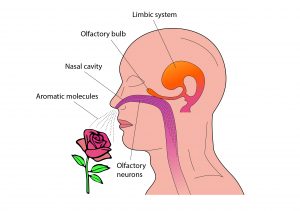 Essential oil molecules, carried within the inhaled breath, sweep across the olfactory epithelium (olfactory bulb), situated at the top of the nasal cavities. A neural signal is transmitted from the olfactory bulb to the limbic area within the brain, also known as ‘the emotional brain’, stimulating the release of hormones and endorphins. Both meditation and essential oils engage the parasympathetic nervous system. An aspect of the autonomic nervous system, and also known as the ‘rest and digest’ system, the parasympathetic nervous system returns the body to a state of calmness post activity, and conserves energy during periods of rest by slowing the heartbeat, increasing intestinal activity, and relaxing muscles.
Essential oil molecules, carried within the inhaled breath, sweep across the olfactory epithelium (olfactory bulb), situated at the top of the nasal cavities. A neural signal is transmitted from the olfactory bulb to the limbic area within the brain, also known as ‘the emotional brain’, stimulating the release of hormones and endorphins. Both meditation and essential oils engage the parasympathetic nervous system. An aspect of the autonomic nervous system, and also known as the ‘rest and digest’ system, the parasympathetic nervous system returns the body to a state of calmness post activity, and conserves energy during periods of rest by slowing the heartbeat, increasing intestinal activity, and relaxing muscles.
Essential oils have various effects, from sedative to stimulant, instilling feelings of being ‘grounded’, uplifted and relaxed. They stimulate mental alertness and concentration. They aid breathing through clearing the sinuses. Frankincense and patchouli slow and deepen breathing, instantly instilling a sense of peace. Lavender and geranium balance and calm emotion. Rosemary aids memory and concentration. Peppermint clears the sinuses and also aids concentration and ‘wakefulness’. Vetiver is grounding
Essential oils can be diffused during meditation, or blended as a perfume in a jojoba oil base, or can be applied using an aroma-stick as a direct inhalant. They can be used for their own therapeutic and hedonistic qualities, to enhance and support mood emotion, concentration and focus, during daily activities, but also, and significantly, to act as a reminder of being in meditation, to recall the ‘there and then’ experience in the ‘here and now’; a gentle hint to continue to focus on awareness of being present.
Perfume and incense bring joy to the heart. Proverbs 27:9
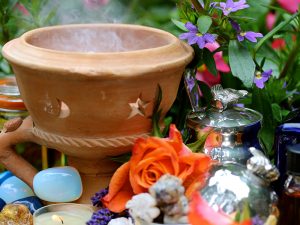
Utilising these multifaceted qualities, there are various ways that essential oils can support yoga; for example, to aid focus, to invigorate or relax mood and emotion, improve ease of breathing, soothe painful muscles, or support subtle energetic flow by gently stimulating the chakras, among many other attributes.
The sense of smell is very personal. Exploring the scent of essential oils and discovering their wonderful qualities is no doubt sensually very enjoyable, but also incredibly practical. As well as their lovely perfumes, which you can wear to enhance your mood and emotion, among other reasons, you will have at hand aids to support your wellness and wellbeing. Essential oils are invaluable companions for mindfulness, meditation, and the practice of yoga; connecting mind, body, and spirit.
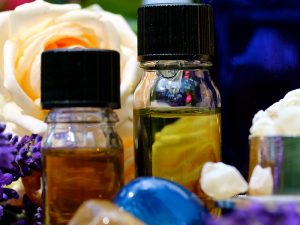
My book, Essential Oils for Mindfulness and Meditation (2019 Janey Loves Platinum award winner), explains in more detail the process of mindfulness and meditation and the supporting role essential oils play, their unique qualities, how they work and how to effectively apply them, and introduces the reader to a group of safe yet very effect oils collectively referred to as Serenity Essential Oils. There is also supporting information about techniques of relaxation, gentle exercise, yoga, basic diet and nutrition. Healing with Essential Oils (2022 Janey Loves Platinum Award winner) provides in depth detail about 58 individual essential oils, their chemistry, the role essential oils play within the plant and how this influences their role within the body, and much more. Essentials for the Whole Body (2020 Janey Loves Platinum award winner) explores how essential oils are absorbed by the body, how to create effective blends and remedies, and includes information about their subtle dynamics, such as their relationship with colour, chakras, gem stones and crystals.
Always check the background details of the essential oils you use to ensure they are compatible for you. Never apply essential oils neat to your skin, as they can be irritant – always blend them in a carrier medium, such as vegetable oil or non-perfumed lotion, cream or ointment. Apply essential oils in moderation; they are highly concentrated – a little goes a long way (2-3 drops at a time, no more than six drops a day when applied topically).
References
Marilú Roxana Soto-Vásquez; Paúl Alan Arkin Alvarado-García. Aromatherapy with two essential oils from Satureja genre and mindfulness meditation to reduce anxiety in humans. Journal of Traditional and Complementary Medicine. Elsevier. 7(1): 121–125. 2017
Heather Dawn Godfrey. Essential Oils for Mindfulness and Meditation. Healing Arts Press, Inner Traditions, Vermont USA. 2018
This article featured in Yoga Magazine, March 2019


